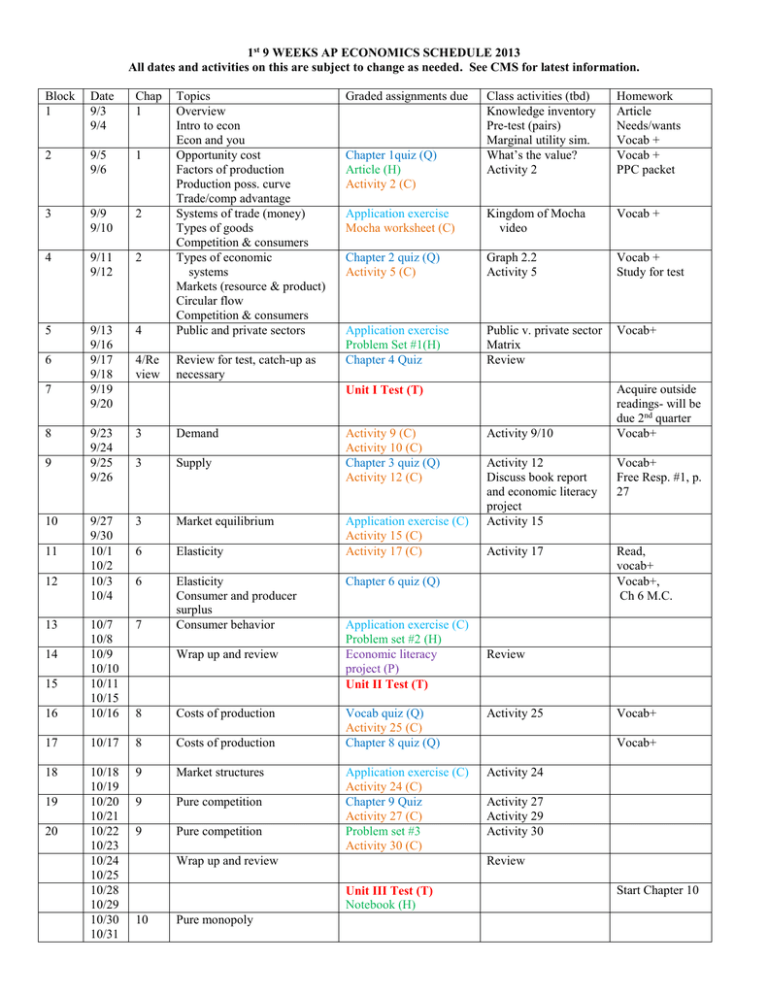Application exercises
advertisement

1st 9 WEEKS AP ECONOMICS SCHEDULE 2013 All dates and activities on this are subject to change as needed. See CMS for latest information. Block 1 Date 9/3 9/4 Chap 1 2 9/5 9/6 1 3 9/9 9/10 2 4 9/11 9/12 2 5 9/13 9/16 9/17 9/18 9/19 9/20 4 Topics Overview Intro to econ Econ and you Opportunity cost Factors of production Production poss. curve Trade/comp advantage Systems of trade (money) Types of goods Competition & consumers Types of economic systems Markets (resource & product) Circular flow Competition & consumers Public and private sectors 4/Re view Review for test, catch-up as necessary 9/23 9/24 9/25 9/26 3 Demand 3 Supply 9/27 9/30 10/1 10/2 10/3 10/4 3 Market equilibrium 6 Elasticity 6 7 16 10/7 10/8 10/9 10/10 10/11 10/15 10/16 Elasticity Consumer and producer surplus Consumer behavior 8 Costs of production 17 10/17 8 Costs of production 18 10/18 10/19 10/20 10/21 10/22 10/23 10/24 10/25 10/28 10/29 10/30 10/31 9 Market structures 9 Pure competition 9 Pure competition 6 7 8 9 10 11 12 13 14 15 19 20 Graded assignments due Class activities (tbd) Knowledge inventory Pre-test (pairs) Marginal utility sim. What’s the value? Activity 2 Homework Article Needs/wants Vocab + Vocab + PPC packet Application exercise Mocha worksheet (C) Kingdom of Mocha video Vocab + Chapter 2 quiz (Q) Activity 5 (C) Graph 2.2 Activity 5 Vocab + Study for test Application exercise Problem Set #1(H) Chapter 4 Quiz Public v. private sector Matrix Review Vocab+ Chapter 1quiz (Q) Article (H) Activity 2 (C) Unit I Test (T) Wrap up and review Activity 9 (C) Activity 10 (C) Chapter 3 quiz (Q) Activity 12 (C) Application exercise (C) Activity 15 (C) Activity 17 (C) Application exercise (C) Problem set #2 (H) Economic literacy project (P) Unit II Test (T) Vocab+ Free Resp. #1, p. 27 Activity 17 Read, vocab+ Vocab+, Ch 6 M.C. Review Vocab quiz (Q) Activity 25 (C) Chapter 8 quiz (Q) Activity 25 Application exercise (C) Activity 24 (C) Chapter 9 Quiz Activity 27 (C) Problem set #3 Activity 30 (C) Activity 24 Vocab+ Vocab+ Activity 27 Activity 29 Activity 30 Review Unit III Test (T) Notebook (H) Pure monopoly Activity 12 Discuss book report and economic literacy project Activity 15 Chapter 6 quiz (Q) Wrap up and review 10 Activity 9/10 Acquire outside readings- will be due 2nd quarter Vocab+ Start Chapter 10 Notebook organization: You will need a three-ring binder for this. The front page will be the table of contents. All work will be logged on this this in the order that it is given, and points possible and points earned should be added as well. The actual assignments will be numbered and placed in the correct order behind the table of contents. This will be collected and reviewed for a grade near the end of the quarter, but the main purpose of the assignment is to enhance your organization and aid your success in this course. Problem Sets: These will be handed out for each unit, and will be due two blocks before the unit test. They will include multiple choice, short answer, and free response questions, and will double as a test review. Key vocab terms: (these are the most significant terms in each chapter, but this is not a comprehensive list of what you need to know) Chapter 1: Economics, utility, marginal utility, scarcity, opportunity cost, production possibilities curve, capital goods, consumer goods, economic growth, factors of production (identify), comparative advantage Chapter 2: Money, barter, command economy, market economy, competition, invisible hand, dollar votes Chapter 4: Durable v. non-durable goods, monopoly, externality, public good, free-rider problem, transfer payment, externality, marginal tax rates, excise tax Chapter 3: Demand, law of demand, diminishing marginal utility, income effect, substitution effect, inferior goods, normal goods, substitute good, complementary goods, supply, determinants of supply, equilibrium price/quantity, surplus, shortage, productive efficiency, allocative efficiency Chapter 6: Price elasticity of demand, unit elasticity, elastic demand, inelastic demand, perfectly elastic demand, perfectly inelastic demand, total revenue test, price elasticity of supply, market period, short run, long run, cross-elasticity of demand, income elasticity of demand, consumer surplus, producer surplus, efficiency loss Chapter 7: Utility, law of diminishing marginal utility, total utility, marginal utility, rational behavior, budget constraints, consumer equilibrium, income effect, substitution effect Chapter 8: Opportunity cost, explicit costs, implicit costs, normal profit, economic profit, total product, marginal product, average product, law of diminishing returns, fixed costs, variable cost, total cost, marginal costs, economies of scale, returns to scale, minimum efficient scale, natural monopoly Chapter 9: Pure competition, imperfect competition, price taker, average revenue, total revenue, marginal revenue, break- even point, MR=MC rule, short-run supply curve, constant-cost industry, increasing cost industry, [productive efficiency, allocative efficiency, consumer surplus, producer surplus in context] Chapter 10: Pure monopoly, barriers to entry, simultaneous consumption, network effects, X-inefficiency, price discrimination, socially optimal price, fair-return price Quizzes: There will be one quiz for almost every chapter, although in rare instances there will be two or none. These will consist primarily of multiple-choice questions covering both vocabulary and content. Unit tests: These will consist of 50 multiple choice questions which will account for 100 points and two free-response questions that will count for 50 points, although they will not always be 25 points each Application exercises: This will generally be one or two free responses designed to reinforce the concepts learned in the unit, AS WELL AS EARLIER UNITS. Classroom activities: These are typically practice problems, graphing activities, or short answer questions designed to reinforce the content covered that day. They will be done in an individual/pair format.





